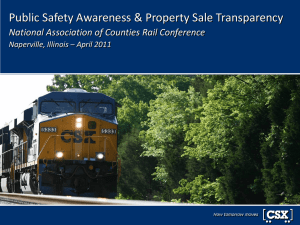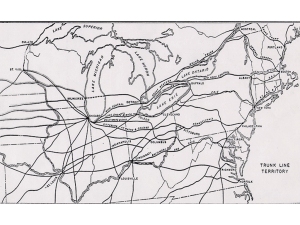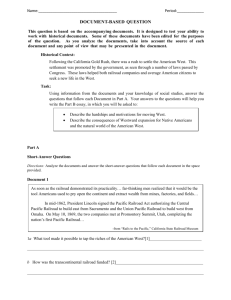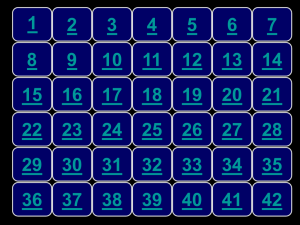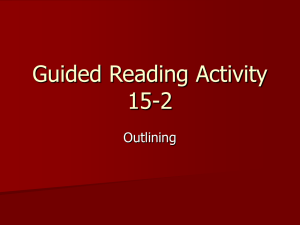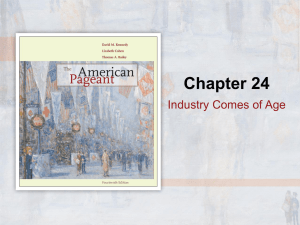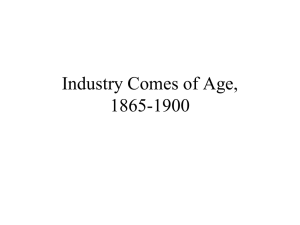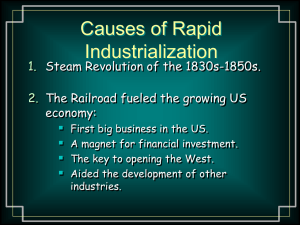America: The Story of Us
advertisement
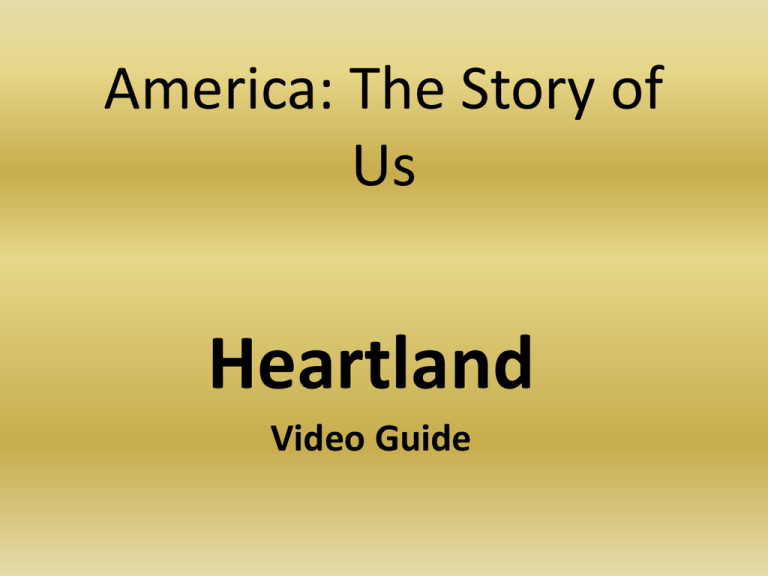
America: The Story of Us Heartland Video Guide 1. What was the biggest obstacle in the way of building the transcontinental railroad? The Sierra Nevada Mountains 2. Who were the two companies that built the railroad? Central Pacific and Union Pacific 3. How does the federal government pay for the railroad? They give federal land to the companies. For every mile of track laid, the government gave 20 square miles of federal land to the railroad companies. 4. Why were Chinese workers chosen to build the railroad? They were excellent workers and it was cheaper to bring Chinese workers across the ocean than other workers across the continent. The Chinese were efficient, fearless, and hardworking. Because they followed their own customs and drank tea instead of unboiled water, they were sick less often than other workers. A great number of Central Pacific’s workers were from China. 5. What happened on May 10, 1869? The tracks from the East and tracks from the West were connected at Promontory Point, Utah. C e n t r a l P a c i f i c U n i o n P a c i f i c The transcontinental railroad was completed in 1869. The Central Pacific and Union Pacific railroads met in Promontory Point, Utah and laid a Golden Spike 6. Where does the railroad trigger a mass migration to? The Great Plains 7. How much of America’s land is given away under the Homestead Act? 10% of the United States • A homesteader had to be 21 years of age and the head of a household • A homesteader would receive 160 acres of public land in the West for free • Each homesteader had to live on the land, build a home, make improvements and farm for 5 years before they were eligible to "prove up". 8. List several obstacles or challenges for settlers. (Get at least 5) Indian raids, bad weather, strong winds, tornadoes, lack of lumber for building material, boundary disputes with cattle ranchers, droughts, prairie fires, locusts, and pests 9. What happened to half the population of western Nebraska by 1892? Half of the population moved back East. 10. What happens to the Great Plains? They become the “Bread Basket” of America. 11. What is “green gold”? lumber or trees 12. Why do so many people come from Norway to America? They were experienced loggers or lumberjacks. 13. How many buffalo were roaming the Great Plains in the 1800’s? 30 million 14. What new hunter arrives on the Great Plains? Buffalo hunters or white man came with their long distance rifle, many of whom were soldiers from the Civil War. 15. Why is there conflict between white people and Indians over the buffalo? Plains Indians depended on and worshipped the buffalo as part of their way of life. White hunters wiped them out for profit. 16. How did the horse change the Indian way of life? Indians became expert horsemen and were able to hunt and fight more effectively. 17. For what purpose did the cowboy develop? They drove cattle from the ranches of Texas to the “cowtowns” or rail hubs of Kansas. 18. Where did the Texas Longhorn come from? They were a product of the wild Spanish cattle and the English cattle that roamed wild. 19. What invention will threaten the cowboy’s way of life? barbed wire 20. What happened to the open range? The open range was closed forever. 21. How long did the “hay day” of the cowboy on the open range last? 20 years 22. Where do most Indians wind up living as settlers moved west? reservations 23. What happened to Lt. Col. George Custer and his men? At Little Bighorn, MT, Custer and his 7th cavalry were slaughtered by Sioux and Cheyenne warriors in less than 3 hours. 24. What happened on December 29, 1890? The 7th Cavalry massacred 200 Sioux and Cheyenne men, women, and children. 25. How did the railroad change time? American railroad companies set up standard time and the US divided into 4 separate time zones. Why did the country need a standard time? It was too difficult to make train schedules when Every community determined its own time, based o calculations about the sun’s travels. RAILROAD AND TIME • Before 1883, each community still operated on its own time • For example: Noon in Boston was 12 minutes later than noon in New York City • Indiana had dozens of different times • No standard time reference PROFESSOR DOWD CREATES TIME ZONES • In 1869, to remedy this problem, Professor C.F. Dowd proposed dividing the earth into 24 time zones • The U.S. would be divided into 4 zones: the Eastern, Central, Mountain, and Pacific • 1883 – Railroads synchronized their watches across U.S. • 1884 – International Conference adopts zones PROFESSOR DOWD EXPLAINS HIS TIME ZONES THE WORLD IS DIVIDED INTO 24 TIME ZONES THE UNITED STATES IS DIVIDED INTO 4 TIME ZONES RAILROADS SPUR OTHER INDUSTRIES • The rapid growth of the railroad industry influenced the iron, coal, steel, lumber, and glass businesses as they tried to keep up with the railroads demand for materials • The spread of the railroads also led to the growth of towns, new markets, and opportunity for profiteers RAILROADS LED TO GROWTH OF CITIES • Many of today’s major cities owe their legacy to the railroad • Chicago, Minneapolis, Denver, and Seattle all grew up thanks to the railroad • Part of transportation network that crossed the country “MY KIND OF TOWN” 26. How did Richard Sears change the way Americans shopped? He developed the mail order catalog, utilizing mail and railroads to ship goods.

